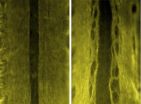(Press-News.org) Large amounts of a substitute for one of the world's most treasured fragrance ingredients — a substance that also has potential anti-cancer activity — could be produced with a sustainable new technology, scientists are reporting. Published in the Journal of the American Chemical Society, the advance enables cultures of bacteria to produce a substitute for natural ambergris, which sells for hundreds of dollars an ounce.
Laurent Daviet, Michel Schalk and colleagues explain that ambergris, a waxy substance excreted by sperm whales, has been prized as a fragrance ingredient for centuries. Ambergris has a pleasant sweet and earthy scent of its own, and it enhances other scents in high-end perfumes. With sperm whales an endangered species, and natural ambergris not used in perfumes in the U.S., perfume makers have turned to substitutes. One is made from sclareol, obtained from the Clary sage plant. But the plant contains only small amounts of sclareol, and it is laborious to extract and purify. That's why the scientists looked for a better way of making large amounts of sclareol.
Their report describes isolating the genetic material (DNA) that produces the two Clary sage enzymes needed to make sclareol. They put the DNA into bacteria, which made large amounts of sclareol in bioreactors.
###The American Chemical Society is a nonprofit organization chartered by the U.S. Congress. With more than 164,000 members, ACS is the world's largest scientific society and a global leader in providing access to chemistry-related research through its multiple databases, peer-reviewed journals and scientific conferences. Its main offices are in Washington, D.C., and Columbus, Ohio.
To automatically receive news releases from the American Chemical Society, contact newsroom@acs.org.
Follow us: Twitter | Facebook
Sustainable way to make a prized fragrance ingredient
2012-12-19
ELSE PRESS RELEASES FROM THIS DATE:
Wine and tea are key ingredients in South African plan to grow domestic research
2012-12-19
The South African government is investing in scientific research to foster production of agricultural products like pinotage (the country's signature red wine) and honeybush (source of a tea so fragrant that a potful can perfume an entire house) to create jobs and boost the economy. That effort and others aimed at developing a globally competitive research enterprise are the topics of cover stories in the current issue of Chemical & Engineering News (C&EN), the weekly newsmagazine of the American Chemical Society, the world's largest scientific society.
Britt E. Erickson, ...
University of Texas at Austin Team develops a microwave-assisted method for producing thin films
2012-12-19
Growth of new materials is the cornerstone of materials science - a highly inter-disciplinary field of science that touches every aspect of our lives from computers and cell phones to the clothes we wear. At the same time, the energy crisis has brought the spotlight on synthesis and growth of materials for clean energy technologies, such as solar cells and batteries. However, researchers in these areas do not simply grow materials —they assemble the atoms and molecules that form so-called thin films on various substrates. It is a process that is highly complex, time-consuming ...
Described a key mechanism in muscle regeneration
2012-12-19
Researchers at the Bellvitge Biomedical Research Institute (IDIBELL) have described a new selective target in muscle regeneration. This is the association of alpha-enolase protein and plasmin. The finding could be used to develop new treatments to regenerate muscular injuries or dystrophies. The study has been published in PLOS ONE journal.
Skeletal muscle has a great regeneration capacity after injury or genetic diseases such as Duchenne muscular dystrophy, the most common neuromuscular disorder in children. This condition is due to a defect in the gene of dystrophin, ...
Experiencing discrimination increases risk-taking, anger, and vigilance
2012-12-19
Experiencing rejection not only affects how we think and feel — over the long-term it can also influence our physical and mental health. New research suggests that when rejection comes in the form of discrimination, people respond with a pattern of thoughts, behaviors, and physiological responses that may contribute to overall health disparities.
"Psychological factors, like discrimination, have been suggested as part of the causal mechanisms that explain how discrimination gets 'under the skin' to affect health," says psychological scientist and senior researcher Wendy ...
UC Irvine study of leaping toads reveals muscle-protecting mechanism
2012-12-19
Irvine, Calif., Dec. 19, 2012 — Most people are impressed by how a toad jumps. UC Irvine biologist Emanuel Azizi is more impressed by how one lands.
An assistant professor of ecology & evolutionary biology who specializes in muscle physiology and biomechanics, Azizi found that nature's favorite leapers possess a neuromuscular response that's specific to the intensity of a landing – a mechanism that protects muscles from injury upon impact.
The research is helping reveal how the nervous system modulates motor control patterns involved with jumping and landing. Azizi's ...
Healthy lifestyle during menopause may decrease breast cancer risk later on
2012-12-19
Obese, postmenopausal women are at greater risk for developing breast cancer and their cancers tend to be more aggressive than those in lean counterparts. A University of Colorado Cancer Center study published in the December issue of the journal Cancer Research shows how this risk might be prevented.
"By using nutrient tracers for fat and sugar, we tracked where the body stored excess calories. In lean models, excess fat and glucose were taken up by the liver, mammary and skeletal tissues. In obese models, excess fat and glucose were taken up by tumors, fueling their ...
Protein creates paths for growing nerve cells
2012-12-19
Working with mice, Johns Hopkins scientists have discovered that a particular protein helps nerve cells extend themselves along the spinal cord during mammalian development. Their results shed light on the subset of muscular dystrophies that result from mutations in the gene that holds the code for the protein, called dystroglycan, and also show how the nerve and muscle failings of the degenerative diseases are related.
As mammals like mice and humans develop, nerve cells in the brain and spinal cord must form connections with themselves and with muscles to assure proper ...
Small, portable sensors allow users to monitor exposure to pollution on their smart phones
2012-12-19
Computer scientists at the University of California, San Diego have built a small fleet of portable pollution sensors that allow users to monitor air quality in real time on their smart phones. The sensors could be particularly useful to people suffering from chronic conditions, such as asthma, who need to avoid exposure to pollutants.
CitiSense is the only air-quality monitoring system capable of delivering real-time data to users' cell phones and home computers—at any time. Data from the sensors can also be used to estimate air quality throughout the area where the ...
Host cholesterol secretion likely to influence gut microbiota
2012-12-19
For more than half a century, researchers have known that the bacteria that colonize the gastrointestinal tract of mammals influence their host's cholesterol metabolism. Now, Jens Walter and colleagues of the University of Nebraska show that changes in cholesterol metabolism induced by diet can alter the gut flora. The research was published online ahead of print in the journal Applied and Environmental Microbiology.
In the study, the researchers added plant sterol esters to the diets of hamsters. The overall effect of this was to inhibit several bacterial taxa, from ...
Tracking the origins of HIV
2012-12-19
URBANA – Human immunodeficiency virus (HIV) may have affected humans for much longer than is currently believed. Alfred Roca, an assistant professor in the College of Agricultural, Consumer and Environmental Sciences at the University of Illinois, thinks that the genomes of an isolated West African human population provide important clues about how the disease has evolved.
HIV is thought to have originated from chimpanzees in central Africa that were infected with simian immunodeficiency virus (SIV), a retrovirus. "If you look at the diversity present across SIV in chimpanzees, ...

